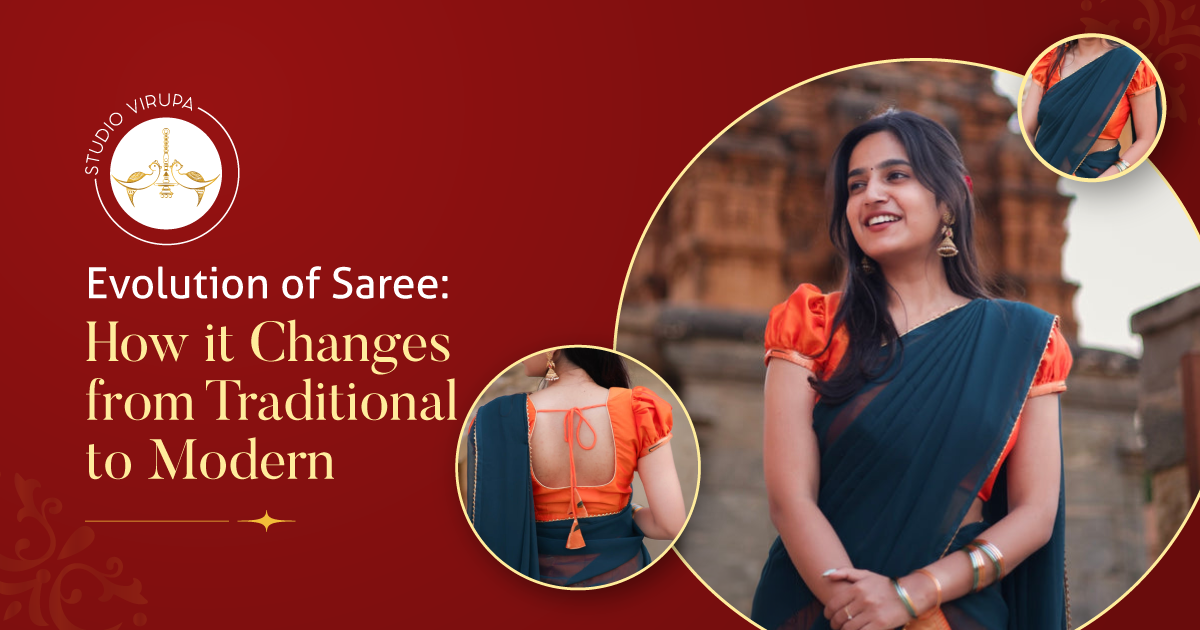Evolution of Saree: How it Changes from Traditional to Modern
Introduction
The saree, a garment synonymous with Indian grace and elegance, boasts a history as rich and vibrant as the fabrics it's crafted from.
Draped for millennia across the diverse landscapes of India, the saree has transcended mere clothing to become a powerful symbol of culture, tradition, and even national identity. Its journey is a fascinating narrative of how fashion adapts and evolves, reflecting the changing times while retaining its timeless essence.
This blog delves into the captivating story of the saree, exploring its transformation from its ancient origins to the modern fashion phenomenon it is today.
Early Elegance: Draped in the Indus Valley Civilization
The saree's roots weave back to the Indus Valley Civilization (3300-1300 BCE), where archaeological evidence suggests early forms of draped garments existed. These early versions likely evolved into the single unstitched cloth we know today around the first century BCE. Drape styles and symbolic significance likely varied across different regions of ancient India.
Mughal Magnificence: A Canvas for Exquisite Craftsmanship
The Mughal era (16th-19th centuries) brought a period of opulence that left its mark on the saree. Silk and brocade became the fabrics of choice, meticulously crafted into canvases for intricate embroidery and rich jewel tones. These sarees reflected the grandeur of the Mughal court, adorned with motifs like paisleys and floral designs. Skilled artisans employed techniques like zardozi, embellishing the sarees with gold and silver threads, creating breathtaking works of art.
Colonial Encounters: The Introduction of the Blouse
British colonisation in the 19th century introduced a new element to the saree's story. The blouse, a garment not traditionally worn with sarees in all regions, became a mandatory addition under British rule. This shift sparked a debate about cultural appropriation and the imposition of Western norms. However, the blouse also opened doors for experimentation. Women began exploring different blouse styles and fabrics, adding a new dimension to the saree's overall look.
Post-Independence: A Symbol of Resurgence and Empowerment
With India's independence in 1947, the saree took on a powerful new meaning. It transcended mere clothing; it became a vibrant symbol of national identity and a celebration of cultural heritage. Prominent women leaders like Indira Gandhi championed the saree, wearing it on the world stage with pride. Designers began experimenting with draping styles, like the Nivi style popular in Maharashtra, and innovative pleating techniques. The saree found a prominent place in the wardrobes of working women and students, signifying empowerment and a break from colonial restrictions.
The Modern Muse: A Fusion of Fabrics and Designs
Today, the saree is a thriving testament to how tradition can embrace contemporary flair. Fabrics like georgette, chiffon, and crepes offer a lighter and more comfortable experience, perfect for the modern woman on the go. Bold digital prints, geometric patterns, and colour blocking reflect a modern aesthetic. Designers are creating sarees that cater to diverse tastes and occasions. One can find the timeless elegance of a handwoven cotton saree with intricate zari borders or the grandeur of a Kanjeevaram saree with its rich silk and gold threadwork. The blouse has become a playground for experimentation, with a variety of necklines, sleeves, and embellishments.
Embrace authentic ethnic wear with Studio Virupa's exclusive designs
With its carefully chosen assortment, Studio Virupa is an exquisite ethnic wear store that honours the rich tapestry of Indian culture. With an emphasis on carefully chosen sarees, lehengas, and Anarkali, the store provides a distinctive fusion of traditional grace and modern flare. Every item from Studio Virupa is a work of art, showcasing exquisite needlework, opulent materials, and classic patterns that demonstrate expert workmanship.
The store serves discriminating clients looking for elegant and genuine ethnic clothing for daily wear as well as special events. With an emphasis on craftsmanship and quality, Studio Virupa offers a customised shopping experience, making sure that each item of clothing not only accentuates the wearer's attractiveness but also captures the rich cultural legacy of India.
A Global Stage: The Saree Beyond Borders
The saree's allure has transcended geographical boundaries. International celebrities like Priyanka Chopra and Deepika Padukone are increasingly embracing the saree for red-carpet appearances, captivating audiences worldwide. Fashion designers are pushing the boundaries, creating fusion silhouettes like saree gowns and saree pantsuits. These innovative designs showcase the saree's versatility and adaptability, sparking a global conversation around this iconic Indian garment.
The saree's evolution is a story of resilience, cultural pride, and continuous reinvention. It is a garment that drapes itself around the wearer, reflecting her personality and evolving with the times. As India continues its journey on the global stage, the saree is certain to keep captivating hearts and turning heads for generations to come.
FAQs
What are the key differences between traditional and modern sarees?
Traditional sarees often feature intricate hand-woven patterns and rich fabrics like silk and cotton, reflecting cultural heritage and regional styles. Modern sarees, however, embrace contemporary designs, lightweight materials, and innovative draping styles, catering to urban fashion trends and practical wear.
How has the saree evolved in terms of fabrics and materials?
While traditional sarees typically use natural fibres like silk, cotton, and jute, modern sarees incorporate a variety of synthetic materials such as chiffon, georgette, and crepe. These modern fabrics offer more versatility, comfort, and ease of maintenance, appealing to the fast-paced lifestyle of today.
In what ways have saree draping styles changed over time?
Traditional saree draping styles are often specific to regions, with each having its unique method and cultural significance. Modern draping styles are more experimental and fusion-oriented, incorporating elements from Western fashion, such as pre-stitched sarees, saree gowns, and pant sarees, making them more accessible and convenient.
How do modern saree designs reflect contemporary fashion trends?
Modern saree designs often integrate contemporary fashion trends such as minimalist aesthetics, bold prints, and asymmetrical patterns. Designers frequently collaborate with fashion houses to introduce new elements like crop tops such as blouses, off-shoulder designs, and modern accessories, making sarees suitable for various occasions, from casual outings to high-profile events.
What role do designers play in the transformation of sarees?
Designers have been pivotal in the evolution of sarees by innovating and pushing the boundaries of traditional designs. They experiment with new fabrics, textures, and embellishments, creating fusion styles that resonate with the global fashion scene. Their collections often highlight the versatility of sarees, showcasing them as chic, modern attire that retains a connection to cultural roots.


